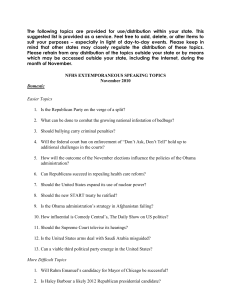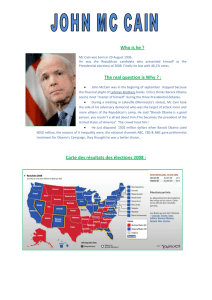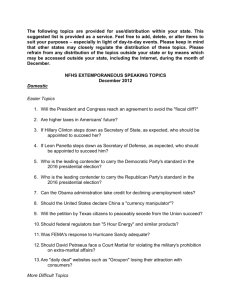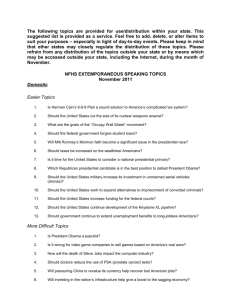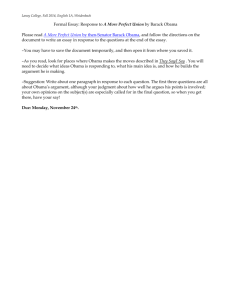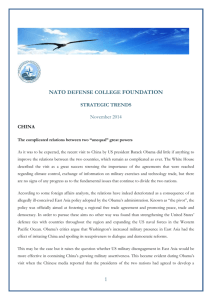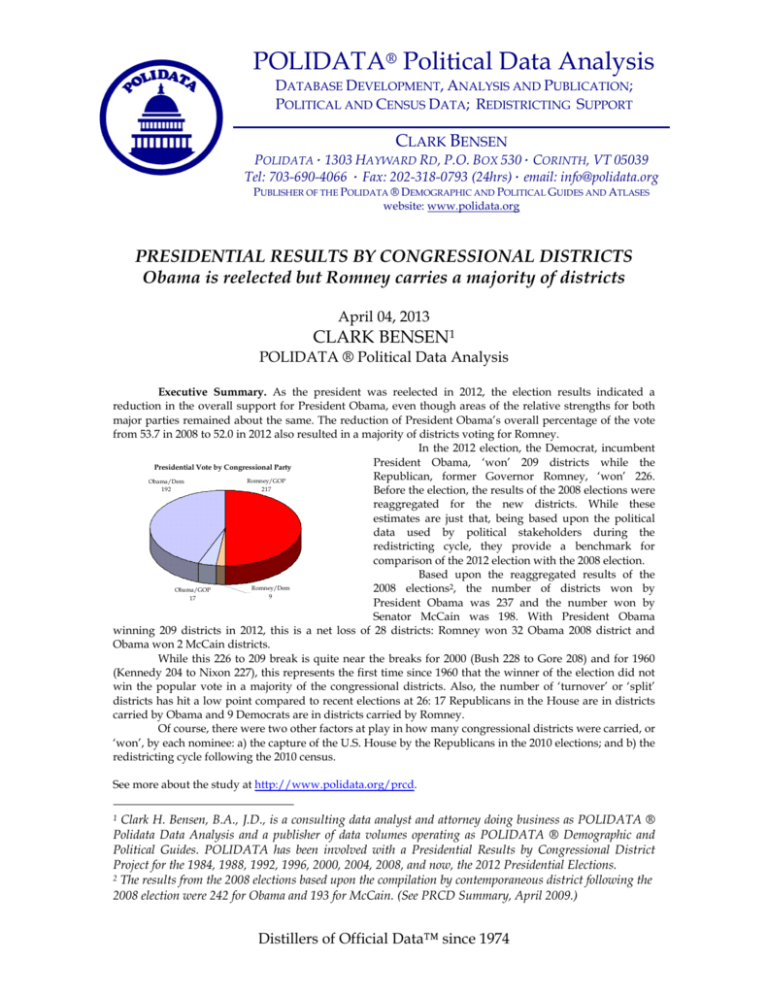
POLIDATA® Political Data Analysis
DATABASE DEVELOPMENT, ANALYSIS AND PUBLICATION;
POLITICAL AND CENSUS DATA; REDISTRICTING SUPPORT
CLARK BENSEN
POLIDATA· 1303 HAYWARD RD, P.O. BOX 530· CORINTH, VT 05039
Tel: 703-690-4066 · Fax: 202-318-0793 (24hrs)· email: info@polidata.org
PUBLISHER OF THE POLIDATA ® DEMOGRAPHIC AND POLITICAL GUIDES AND ATLASES
website: www.polidata.org
PRESIDENTIAL RESULTS BY CONGRESSIONAL DISTRICTS
Obama is reelected but Romney carries a majority of districts
April 04, 2013
CLARK BENSEN1
POLIDATA ® Political Data Analysis
Executive Summary. As the president was reelected in 2012, the election results indicated a
reduction in the overall support for President Obama, even though areas of the relative strengths for both
major parties remained about the same. The reduction of President Obama’s overall percentage of the vote
from 53.7 in 2008 to 52.0 in 2012 also resulted in a majority of districts voting for Romney.
In the 2012 election, the Democrat, incumbent
President Obama, ‘won’ 209 districts while the
Presidential Vote by Congressional Party
Republican, former Governor Romney, ‘won’ 226.
Romney/GOP
Obama/Dem
217
192
Before the election, the results of the 2008 elections were
reaggregated for the new districts. While these
estimates are just that, being based upon the political
data used by political stakeholders during the
redistricting cycle, they provide a benchmark for
comparison of the 2012 election with the 2008 election.
Based upon the reaggregated results of the
Romney/Dem
Obama/GOP
2008 elections2, the number of districts won by
9
17
President Obama was 237 and the number won by
Senator McCain was 198. With President Obama
winning 209 districts in 2012, this is a net loss of 28 districts: Romney won 32 Obama 2008 district and
Obama won 2 McCain districts.
While this 226 to 209 break is quite near the breaks for 2000 (Bush 228 to Gore 208) and for 1960
(Kennedy 204 to Nixon 227), this represents the first time since 1960 that the winner of the election did not
win the popular vote in a majority of the congressional districts. Also, the number of ‘turnover’ or ‘split’
districts has hit a low point compared to recent elections at 26: 17 Republicans in the House are in districts
carried by Obama and 9 Democrats are in districts carried by Romney.
Of course, there were two other factors at play in how many congressional districts were carried, or
‘won’, by each nominee: a) the capture of the U.S. House by the Republicans in the 2010 elections; and b) the
redistricting cycle following the 2010 census.
See more about the study at http://www.polidata.org/prcd.
Clark H. Bensen, B.A., J.D., is a consulting data analyst and attorney doing business as POLIDATA ®
Polidata Data Analysis and a publisher of data volumes operating as POLIDATA ® Demographic and
Political Guides. POLIDATA has been involved with a Presidential Results by Congressional District
Project for the 1984, 1988, 1992, 1996, 2000, 2004, 2008, and now, the 2012 Presidential Elections.
2 The results from the 2008 elections based upon the compilation by contemporaneous district following the
2008 election were 242 for Obama and 193 for McCain. (See PRCD Summary, April 2009.)
1
Distillers of Official Data™ since 1974
Presidential Results by Congressional Districts, 2012
Press Release, April 4, 2013, Page 2
The Project. These conclusions are the result of a months-long study undertaken by
POLIDATA ® POLITICAL DATA ANALYSIS, a demographic and political research firm. The
project was sponsored by two national political publications, the ALMANAC OF AMERICAN
POLITICS, 2014, published by NATIONAL JOURNAL, and the COOK POLITICAL REPORT, a
non-partisan independent reviewer of congressional politics. The data were collected from state
and local election officials for the over 400 county equivalents that contain a portion of more than
one congressional district3. The 2012 presidential election was the first following the 2011-2012
redistricting phase of the congressional apportionment process. POLIDATA has been involved in
the compilation of the Presidential Results by Congressional Districts (PRCD) since the 1984
elections.
In order to compile estimates for the 2008 presidential election under the lines for the
new districts, datasets used by redistricting stakeholders during the remap process were used.
These datasets were reviewed and used to calculate the 2008 election results under both the old
(2010) lines and the new (2012) lines. In some cases adjustments were made to the 2008 data to
address inconsistencies and in other cases adjustments were made once the results for the 2012
elections were estimated for the new lines.
For both the 2008 and 2012 election results, the degree to which the results compiled and
estimated by POLIDATA may match those compiled by others will vary by state and district. For
2008 the data, collected by precinct, were matched to precinct geography and estimates of the
vote were deallocated to each census block that comprised the 2008 precinct on the basis of a
population factor. For 2012 the data were aggregated by POLIDATA from the lowest level of
political geography required: county, town/city, ward, or precinct. However, the two main
issues that affect the final estimates are a) split precincts and b) centrally reported votes, e.g.,
those cast as absentee ballots or at early voting centers4.
The degree to which either or both of the above anomalies will be encountered varies by
state and local jurisdiction. In many states there is only an occasional occurrence of either but in
other states a substantial portion of the vote is reported as such. In order to account for all votes
cast in the presidential election, these votes are allocated to the appropriate low-level geography
by a variety of methods. In most cases the non-split votes are allocated on the basis of the
congressional votes for the unit. However, in numerous cases the congressional vote was
uncontested or unavailable at the same level and other methods of allocation, or factors of
adjustment, were used.
In most cases, the votes for the ‘other’ candidates were compiled to some degree.
Generally, this included three candidates who appeared on the ballots in many states: Gary
Johnson, Jill Stein, and Virgil Goode. In a few states votes for another candidate may have been
included (e.g., Roseanne Barr in California). While a substantial portion of the independent vote
Data assistance was provided by the Republican National Committee. District votes for New York were
compiled by Skyline Consulting. Fortunately, more states provided the basic information for this project in
2012 than previously. Unfortunately, some states could not provide it in time for the project and in a few
cases what was provided was problematic. Thus, all data are still preliminary.
4 Appropriately tabulating votes for all offices for all districts, congressional, legislative and local, would
greatly facilitate analysis by those who are interested in the political behavior of our representative
districts, be they academics, politicians, citizens, or the courts. It would also make the entire vote tabulation
process more transparent and thus easier to understand and review so as to assess the integrity of the
overall process whereby we peacefully transition political power.
3
Copyright © 2013. Polidata ®. All Rights Reserved. www.polidata.org
Presidential Results by Congressional Districts, 2012
Press Release, April 4, 2013, Page 3
is included, it is not complete in these results. To the extent that they were included it is clear that
they represented a very small fraction of the vote, generally under 2%. Moreover, most analysis
of the presidential vote by district focuses on the two-party vote.
Turnovers and Changes. There were 26 ‘turnover’, or ‘split-ticket’ districts: those that
elected a member to the U.S. House that was a party other than the winner of the presidential
vote in the district. In 2012, Obama won 17 districts that elected a Republican to the 113th
Congress while Romney won 9 districts that elected a Democrat. This represents a dramatic
decrease over recent elections. For example, following the 2008 elections the overall number of
turnovers was 83 and following the 2004 elections the number was 59.
2 1
6
10
1
5
7
9
8
4
5
3
2
3
A.L.
A.L.
8
1
4
7
2
7
2
6
354
2
1
A.L.
1
3
5 6
7
11 9
12
13
14
15 10
4
17
18
19
16
20
22
21
3
4
2
4
23
8
25
2630
29
28
27
34
33
37
3
2
40
31
35
43
38
39
44
46
4541
48
42
47 49
36
50
52
53
51
2
3
3
5
1 2
1
17
2
3
716
4
2
1
3
3
86
795
5
13
9
3
2
12
1
8
3
2
1
2
4
7
4
9
5
1
4
4
2
3
19
26 3
32
12 24
33
30
6
2
16
11
23
1
25
17
31
21 35
20
2
10
27
A.L.
28 15
34
6
5
1
3
1
5
7 6
8
7
1
15
21
3
4
4
4
4
13
5
3
1
8
18
6
6
2
4
7
5
1
2
4
8
36
2
718
929
22
14
3
5
4
3
6
2
1
1
1
A.L. 2
1
1
6
357
1 2 48 9
10
1
5 12 2
3
18
811
4
9
1
14
13
16
10
51117
3
13
9
15
14
6
12
7 12
14 3
8
10
7
5
10
9
8
542
11
1117 712
9 11
15 8 46
13
16
2
5
7613
1 3
7
1412 9
4 16 12
4
18
12
8 732 A.L.
6
4 1
8 315 6
1011
1
10
8
5
1
2
2
7 1
6
4
2
3
3
6
5
4
5
9
1
6
5
3
1
4 13
2
12
2
3
11 10 9 8
7
4
5
7
3
1411 9
67
2
5 4 10
6
13
1
3 3
12
25 24 22
2627
23
5
4
6
2
5 4
3
1
6
10
97
684
14
5
3 1
11
2 3
16 1
2
3
2
4
2
24
21
8
A.L.
1
2
1
2
8
20
19
1
4
2
3
56
11 7
10
1215 9 8
13
14
18
16 17
2021
22
19 25 23
24
27
26
Figure 1. Turnover Districts (red: Romney Democrats; blue: Obama Republicans).
Of course, as mentioned above, there were at least two events that likely had a major
impact on the realignment of the presidential vote by district: a) the takeover of the House by the
Republicans in 2010; and b) the redistricting phase of the apportionment process that occurred
since the 2008 elections. Clearly, having more Republicans elected in 2010 was of benefit to the
Republicans but this was coupled with the enormous success the Republicans had nationwide in
2010 in capturing state legislatures, most of which have some impact on the drawing of
congressional lines.
As the first congressional election under the new lines was to be a presidential one as
well, it made sense to make the results of the most recent presidential election in 2008 a primary
ruler against which all districts were reviewed. Likewise, to many stakeholders it is the generic
value of the presidential vote that makes the previous presidential election a good guide for an
election to be held in any new district, especially one with a presidential incumbent and/or one
without a congressional incumbent on the ballot. In other cases new districts were drafted simply
to be a ‘toss-up’ district and these results from 2012 will supply a chance to review those.
Using the re-aggregations of the 2008 elections it is also possible to compare and see
where the overall loss of support for the president translated into a ‘loss’ or ‘gain’ over 2008.
Copyright © 2013. Polidata ®. All Rights Reserved. www.polidata.org
Presidential Results by Congressional Districts, 2012
Press Release, April 4, 2013, Page 4
There are 32 districts in which the ‘winner’ for the 2008 elections (under the new lines) was
different in 2012. Obama won 2 districts that McCain had won and Romney won 30 districts that
Obama had won in 2008. Compare this with the post-2008 election review in which there were 65
districts that changed since the previous election. Following the 2008 elections, Obama won 64
districts that Bush had won in 2004 and McCain won only 1 district that Kerry had won in 2004.
Regional Patterns. The results of the analysis confirmed regional patterns of split-ticket
voting. In the East, Obama won 58 and Romney won 20 districts. With 53 Democrats in the East,
this is a net of +5 for Obama. (The net here is determined by simply comparing the number of
members elected to the House with the number of districts won for the presidential nominees.) In
the Midwest, Obama won 37 districts and Romney won 57. With 35 Democrats, this is a net of +2
for Obama. In the South, Obama won 48 districts and Romney won 113. With 50 Democrats in the
South, this is a net of -2 for Obama. In the West, Obama won 60 districts and Romney won 36.
With 63 Democrats in the West, this is a net of +3 for Obama. Nationally, with 201 Democrats
elected in the November 2012 elections, and 209 Obama districts, the overall net for Obama is a
+8. Nationally, following the 2008 elections, the net for Obama was -15.
Figure 2. Change in Obama % over 2008 (lighter shading is a decrease).
The 2012 elections were the first held after the apportionment mandated by the 2010
census so the number of members has changed by state and region. Under the old map, the
number of districts won by Obama following the 2008 elections was 242 and under the new map,
the number won by Obama following the 2012 elections was 209. The differential shift was not
evenly spread across the four regions of the country. Obama’s net gains and losses under the old
map and the new map are -8 in the East; -23 in the Midwest; -4 in the South; and +2 in the West.
The loss of support for the president in the Midwest was prevalent in most areas.
Of the 16 states with turnover districts, 4 states had 3 each: California; Florida;
Minnesota; and New York. There are Obama Republicans in 10 states and Romney Democrats in
8 states. Aside from the 7 single-member at-large states, the number of states in which all districts
Copyright © 2013. Polidata ®. All Rights Reserved. www.polidata.org
Presidential Results by Congressional Districts, 2012
Press Release, April 4, 2013, Page 5
were carried by Obama is 6: ME, NH, MA, RI, CT, and HI; the number in which all districts were
carried by Romney is 7: WV, KS, NE, OK, AR, ID and UT.
The House delegations after 2012 break as follows: 17 with more Democrats than
Republicans and 30 with more Republicans than Democrats: 3 delegations are tied (NJ, IA, and
NV). President Obama carried a majority of the districts in 20 states and won 26 states for the
Electoral College vote. Had there been a uniform application of the Electoral Vote by
Congressional District method, Obama would have won 264 votes (209 for each district plus 2 for
each of the 26 states he won in the popular vote, plus 3 for DC) versus the 332 actually cast for the
ticket5. Such a proposal would have given Obama 49.1% of the electoral vote. This would result
in a difference between his share of the two-party popular vote (52.0%) and the Electoral College
vote (61.7%), from a bonus of +9.7 points to a deficit of -2.9 points.
District Highlights. The study also highlights some other factoids about the presidential
election from the perspective of a tally by congressional district. For example:
The top five Obama districts are: Jose Serrano (NY:15) at 94%; Charlie Rangel (NY:13) at
90%; Chaka Fattah (PA:2) at 90%; Gregory Meeks (NY:5) at 90%; and Hakeem Jeffries
(NY:8) at 89%.
The top five Romney districts are: Mac Thornberry (TX:13) at 80%; Michael Conaway
(TX:11) at 79%;Jason Chaffetz (UT:3) at 79%; Doug Collins (GA:9) at 78%, and Rob Bishop
(UT:1) at 78%.
There are five Obama districts currently held by Republicans in the House in which Obama
received more than 52% of the vote: Gary Miller (CA:31) at 57%; David Valadao (CA:21) at
55%; Frank LoBiondo (NJ:2) at 54%; Ileana Ros-Lehtinen (FL:27) at 53%; and Jon Runyan
(NJ:3) at 52%.
There are five Romney districts currently held by Democrats in the House in which Romney
received more than 52% of the vote: Jim Matheson (UT:4) at 68%; Nick Rahall (WV:3) at
65%; Mike McIntyre (NC:7) at 59%;John Barrow (GA:12) at 55%; Collin Peterson (MN:7)
at 54%.
The 9 Romney Democrats are found in 8 states: AZ (2); FL; GA; MN; NC; TX; UT; and WV.
The 17 Obama Republicans are found in 10 states: CA (3); CO; FL (2); IA, MN (2); NV, NJ
(2); NY (3); VA; and WA.
There are 2 districts that voted for McCain in 2008 but for Obama in 2008: Michael Grimm
(NY:11); and Ileana Ros-Lehtinen (FL:27).
There are 30 districts that voted for Obama in 2008 but Romney in 2012: 20 of these 30 are in
four states with 7 in Michigan; 5 in Pennsylvania; 4 in Illinois; and 4 in Wisconsin.
There are 22 districts in which the margin that determined the presidential winner was under
2%: Obama won 10 of them and Romney won 12.
The degree to which the party caucuses of the U.S. House change vis-à-vis the generic
vote for President continues to change over the decades. Both caucuses now have more than 90%
of their members in districts that voted for their party’s nominee for President (96% for the
Democrats and 93% for the Republicans). With only 209 districts voting for Obama, and only 17
Obama Republicans, the pool of members to whom the Obama White House can appeal has
shrunk.
Voter Turnout. This project once again confirms the variation in the turnout amongst
districts and how this translates into a disparity of the weight of a vote depending upon where
Nebraska and Maine actually use the Congressional District vote for their electoral votes. Unlike 2008,
there was no breakup of these delegations: ME: 2 for Obama; NE: 3 for Romney.
5
Copyright © 2013. Polidata ®. All Rights Reserved. www.polidata.org
Presidential Results by Congressional Districts, 2012
Press Release, April 4, 2013, Page 6
one resides. Even in California, the range of the district with the largest number of votes cast for
president, Waxman (CA:33) with 346,000 votes, was nearly 3 times greater than the number of
votes cast for president in the district with the smallest number of votes, Valadao (CA:21) with
119,000 votes: each vote cast in CA:21 had the weight of 3 votes cast in CA:33. Excluding the
single-member at-large states, the average vote in the ten districts with the highest number of
votes for president was 407,000; the average vote in the ten districts with the lowest number of
votes for president was 140,000, a ratio of 2.9.
[D:\poligeo\us\amb\2012\wpr_prcd12_md04b.doc~4/4/2013 12:12:00 PM]
Copyright © 2013. Polidata ®. All Rights Reserved. www.polidata.org

